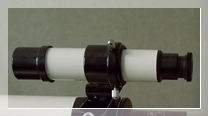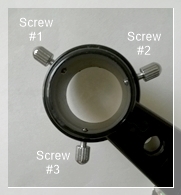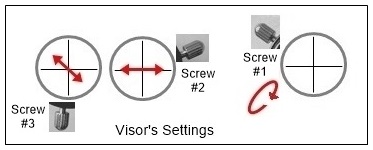
 Observation
Observation 
 How to Tune a Classical Three-screw Telescope's Visor?
How to Tune a Classical Three-screw Telescope's Visor?
To tune a classicial three-screw visor, like the one pictured below, using the base's screws is not that easy. Without any accurate instructions of use -which often is the case even with pricy telescopes- a amateur astronomer will easily get confused! Here are some useful bases, which will allow to a easier tuning of your telescope's visor
- once your telescope on station, just tune the visor base's screws so that they each are set to the same value relative to the base's barrel. That setting further will take care to be able to fit the visor into
- then just fit the visor into and screw the three screws with a moderate screwing, with each the same one. For achieving that, screw each screw, one by one, with a same value and repeat that until the visor be locked. Note! It looks like to achieve a perfect screwing equality for three screws!
- have a low magnification-yielding ocular into your telescope and bring to the field's center the objet you chose like a target like a tree's or pole's top, or a TV antenna, for example). Tune image. If needed lock the mount (following instructions of use) to avoid any interfering move during settings
- back to visor, you will have the reference target usually slightly shifted relative to the visor's reticle
- unscrew three visor base's screws of a minute -albeit allowing tuning- value, the same for each
- now take like a principle that screw #1 will be used to lock settings, screw #2 is allowing to a horizontal motion and screw #3 a diagonal one (such those numbers are appropriate to tuning the settings only, and usually not defined like by official instructions of use)
- using srews #2 and 3 only, now just bring the visor's reticle upon the target. And screw screw #1. A that screwing may yield a slight shift, adjust your settings and srew again. Now, just shift your target as seen in the visor and center it back (like if you were aiming to that object during a observation); check withing the ocular whether the target keeps at the field's center. If yes, equally screw three screws to a good lock of the visor. If not, adjust the settings again, and screw equally
Here you are. Your telescope now works with a fine-tuned visor which will allow for easier observations! Do not forget to unscrew your visor one the observation session over, which looks like a good practice -should it avoid any stress upon the visor when the telescope is at rest! On a other hand, that also depends upon your own practice
Website Manager: G. Guichard, site 'Amateur Astronomy,' http://stars5.6te.net. Page Editor: G. Guichard. last edited: 2/11/2016. contact us at ggwebsites@outlook.com



